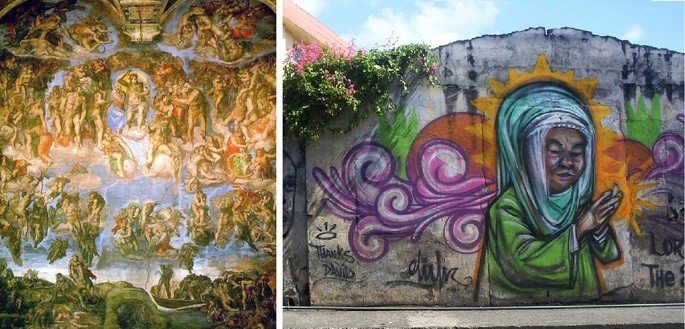
What is Sacred Art
Sacred art is the set of artistic manifestations related to religiosity and which are included in cults and religious places.
Generally, this type of art is associated with Christianity, however, even “pagan” religions have their sacred art.
It manifests itself through paintings, sculptures, mosaics, architecture, music, clothing and utensils.
Although there is a strong relationship between sacred art and religious art, there are differences between them, due to their purposes.
On the left, an example of sacred art, the painting The Last Judgment, by Michelangelo, present in the Sistine Chapel. On the right, urban graffiti displaying religious art
In both manifestations the motivation is religiosity and devotion, however, sacred art has a more specific objective.
It is necessarily inserted in the sacred environment, such as temples and churches, the “liturgical spaces”, generally exhibiting a ritualistic characteristic.
Its function is to assist believers in their spiritual practices, whether by explaining biblical passages or providing inspiration to strengthen faith.
Religious art, however, is not necessarily sacred. This is because it can be inserted in the most varied locations, whether in domestic or urban environments, as in the case of street art murals, for example.
Therefore, we can say that all sacred art is a type of religious art, but the same does not apply the other way around.



- April 11, 2025
Gallery of Posters from the DDD Gallery Archive – Japan





- April 10, 2025
Luis Felipe Noé Dies at 91

- April 10, 2025
Impact of AI on the Diversity of Artistic Production

- April 10, 2025
Impact of AI on the Diversity of Artist…

- April 10, 2025
How can AI enhance artistic creativity?

- April 09, 2025
The Impact of Artificial Intelligence o…

- April 08, 2025
Latin American art, a goldmine of oppor…

- April 07, 2025
Contemporary Art in Brazil: Between the…

- April 07, 2025
Mexican Muralism: Art for the People

- April 06, 2025
History of graphic art in Brazil

- April 05, 2025
Modern Art: A Renaissance in Art History

- April 02, 2025
Aldo Estrada (Ilustronauta): From Peruv…

- March 31, 2025
How ChatGPT is Turning Photos into Japa…

- March 30, 2025
Arístides Hernández (ARES): A Sharp Min…

- March 30, 2025
The Masters of Cuban Caricature: Celebr…

- March 29, 2025
Where Will Artificial Intelligence Take…

- March 27, 2025
A Few Fascinating Features of Latin Ame…

- March 27, 2025
9 Key Books to Understand Latin America…

- March 26, 2025
The Underground: A Glimpse into 1930s L…

- March 24, 2025
Odysseus and Polyphemus – 1896

- March 21, 2025
Dalcio Machado – A Leading Voice in Con…

- March 20, 2025
Cau Gomez: A Master of Brazilian Carica…

- March 20, 2025
The Greatest Visual Artists of Bolivia …

- August 29, 2023
The history of Bolivian art

- February 19, 2024
Analysis and meaning of Van Gogh's Star…

- January 28, 2024
Culture and Art in Argentina

- September 25, 2023
What is the importance of art in human …

- September 23, 2023
What is paint?

- August 10, 2023
14 questions and answers about the art …

- August 30, 2023
First artistic manifestations

- August 23, 2023
The 11 types of art and their meanings

- March 26, 2024
The importance of technology in art1

- August 16, 2023
The 15 greatest painters in art history

- April 06, 2024
History of visual arts in Ecuador

- September 23, 2023
History of painting

- March 26, 2024
Cultural identity and its impact on art…

- January 31, 2024
Examples of Street Art – Urban Art

- January 20, 2024
What is the relationship between art an…

- October 21, 2023
Contemporary art after the Second World…

- April 07, 2024
Graffiti in Latin American culture

- August 25, 2024
A Comprehensive Analysis of the Cartoon…

- September 23, 2023
Painting characteristics

- January 12, 2024
10 most beautiful statues and sculpture…

- February 19, 2024
Analysis and meaning of Van Gogh's Star…

- August 13, 2023
9 Latino painters and their great contr…

- August 29, 2023
The history of Bolivian art

- August 10, 2023
14 questions and answers about the art …

- January 28, 2024
Culture and Art in Argentina

- August 23, 2023
The 11 types of art and their meanings

- November 06, 2023
5 Latin American artists and their works

- September 23, 2023
Painting characteristics

- August 27, 2023
15 main works of Van Gogh

- September 23, 2023
What is paint?

- September 25, 2023
What is the importance of art in human …

- August 30, 2023
First artistic manifestations

- January 20, 2024
What is the relationship between art an…

- January 12, 2024
10 most beautiful statues and sculpture…

- December 18, 2023
10 iconic works by Oscar Niemeyer, geni…

- October 30, 2023
Characteristics of Contemporary Art

- March 26, 2024
Cultural identity and its impact on art…

- August 22, 2023
What are Plastic Arts?

- April 16, 2024
The most important painters of Latin Am…

- October 11, 2023


